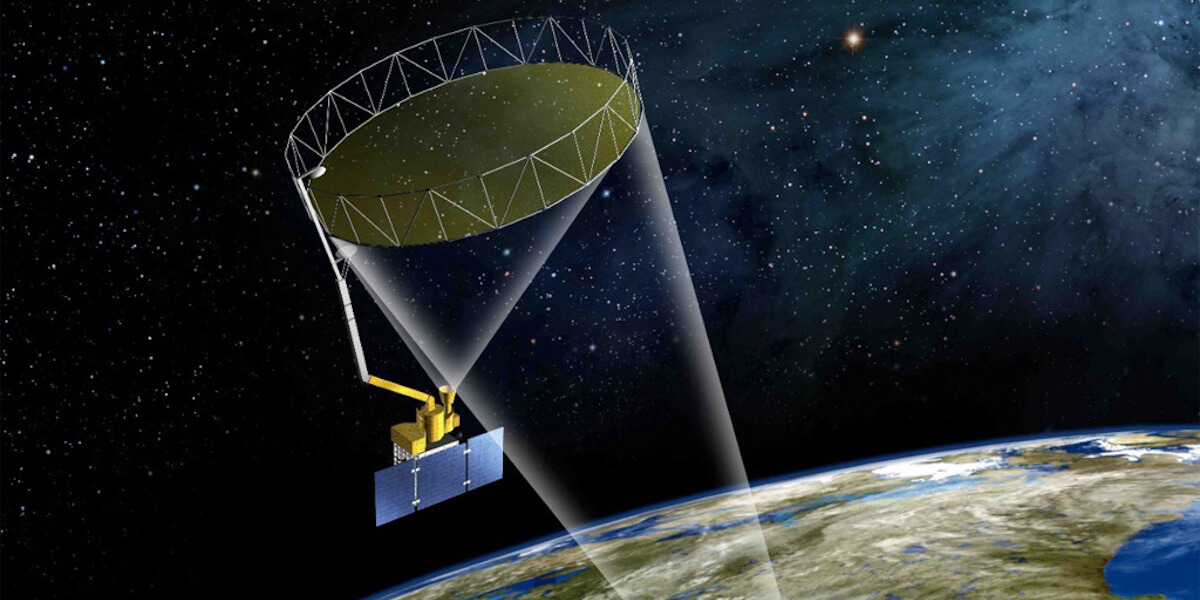
Artist’s rendering of the Soil Moisture Active Passive (SMAP) satellite. Credit: NASA Jet Propulsion Laboratory
Think keeping your coffee warm is important? Try satellites. If a satellite’s temperature is not maintained within its optimal range, its performance can suffer which could mean it could be harder to track wildfires or other natural disasters, your Google maps might not work and your Netflix binge might be interrupted. This might be prevented with a new material recently developed by USC Viterbi School of Engineering engineers.
When satellites travel behind the Earth, the Earth can block the sun’s rays from reaching the satellites—cooling them down. In space, a satellite can face extreme temperature variation as much as 190 to 260 degrees Fahrenheit. It’s long been a challenge for engineers to keep satellite temperatures from fluctuating wildly. Satellites have conventionally used one of two mechanisms: physical “shutters” or heat pipes to regulate heat. Both solutions can deplete on-board power reserves. Even with solar power –the output is limited. Furthermore, both solutions add mass, weight and design complexity to satellites, which are already quite expensive to launch.
Taking cues from humans who have a self-contained system to manage internal temperature through homeostasis, a team of researchers including Michelle L. Povinelli, a Professor in the Ming Hsieh Department of Electrical Engineering at the USC Viterbi School of Engineering, and USC Viterbi students Shao-Hua Wu and Mingkun Chen, along with Michael T. Barako, Vladan Jankovic, Philip W.C. Hon and Luke A. Sweatlock of Northrop Grumman, developed a new material to self-regulate the temperature of the satellite. The team of engineers with expertise in optics, photonics, and thermal engineering developed a hybrid structure of silicon and vanadium dioxide with a conical design to better control the radiation from the body of the satellite. It’s like a textured skin or coating.
Vanadium dioxide functions as what is known as a “phase-change” material. It acts in two distinct ways: as an insulator at low temperatures and a conductor at high temperatures. This affects how it radiates heat. At over 134 degrees Fahrenheit (330 degrees Kelvin), it radiates as much heat as possible to cool the satellite down. At about two degrees below this, the material shuts off the heat radiation to warm the satellite up. The material’s conical structure (almost like a prickly skin) is invisible to the human eye at about less than half the thickness of a single human hair—but has a distinct purpose of helping the satellite to switch its radiation on and off very effectively.
Results
The hybrid material developed by USC and Northrop Grumman is twenty times better at maintaining temperature than silicon alone. Importantly, passively regulating heat and temperature of satellites could increase the life span of the satellites by reducing the need to expend on-board power.
Applications on Earth
Besides use on a satellite, the material could also be used on Earth for thermal management. It could be applied to a building over a large area to more efficiently maintain a building’s temperature.
The study, “Thermal homeostasis using microstructured phase-change materials,” is published in Optica. The research was funded by Northrop Grumman and the National Science Foundation.
The researchers are now working on developing the material in the USC microfabrication facility and will likely benefit from the new capabilities in the recently-dedicated John D. O’Brien Nanofabrication Laboratory in the USC Michelson Center for Convergent Bioscience.
Published on December 5th, 2017
Last updated on May 16th, 2024












